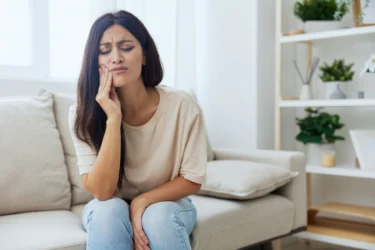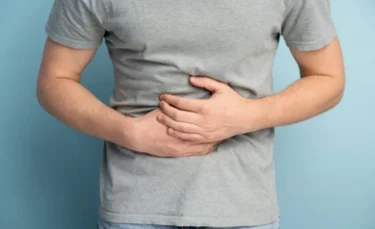Ajwain (Carum copticum), also called bishop’s weed, is a herb that is used as a spice and a major ingredient in different types of medicines. It is thought to have originated in Egypt and the eastern Mediterranean region. Ajwain is extensively cultivated in black soil, especially along the riverbanks in Egypt and several other countries like Iran, Afghanistan, and India. The seeds are small yet have a hot, pungent, and bitter taste. Ajwain functions as a stomachic (helping promote appetite or helping in digestion) and laxative, and is used as an appetiser. It may be helpful for conditions like piles, abdominal tumours, abdominal pain, vomiting, mouth diseases, etc1.
The major constituent of ajwain is an essential oil called thymol, which constitutes about 35-60%. The seed also contains compounds like β-pinene, para-cymene, α-pinene, limonene, and γ- and β-terpinenes3. Ajwain seeds also comprise protein, fat, fibre, minerals, calcium, iron, phosphorus, carotene, riboflavin, niacin, thiamin, and carbohydrates. In 100 grams of ajwain, the nutrients found are1,2:
Ajwain is known to have many properties like3:
Ajwain may help reduce irregular intestinal and stomach pain in both adults and children. Taking ajwain with common salt and warm water may relieve colicky pain (sharp intestinal pain) caused by gas, indigestion, or intestinal infections. It can also be taken with buttermilk to ease digestion-related issues1. Consult your doctor before taking it for any condition.
A mixture of ajwain and ginger may be prescribed by your doctor in cases of chronic bronchitis and asthma. This mixture might help expel mucus and may improve the symptoms of chronic bronchitis and asthma. It may also be helpful for chronic colds and coughs. Consuming warm water after chewing ajwain might help reduce a cough. Chewing betel leaf with ajwain might help with a dry cough1. It is, however, essential to consult your doctor before taking it for these conditions.
Ajwain seeds may be helpful for diabetes4. Powdered neem leaves can be taken with warm milk along with powdered ajwain and cumin seeds. This combination might help reduce blood sugar levels. However, it’s essential to consult your doctor before taking this. Moreover, a condition like diabetes must be diagnosed and treated by a doctor.
Smelling ajwain seeds wrapped in a tissue may help in dealing with migraines3. Ajwain seeds can also be burned, and the fumes inhaled, to address other head-related issues1. However, such effects need to be proved by further research. Moreover, it is essential to consult a doctor before using ajwain for any apparent health benefits.
Ajwain seed oil may be helpful for pain related to arthritis3. This oil can be used regularly for massage on the affected joints to alleviate pain in rheumatic arthritis1. Kindly consult a doctor before using it.
Consuming ajwain seeds might be a natural way to help deal with diarrhoea or dysentery5. A handful of ajwain seeds can be boiled and added to a glass of water. This mixture can be cooled and consumed to help with diarrhoea. However, such effects need to be ascertained by further research.
Ajwain seeds might also be used as an insecticide6. Moreover, they may also be used for poisonous insect bites.
Although studies showing the potential uses of ajwain in various conditions are limited, there is a need for further research to establish the true extent of ajwain’s benefits on human health.
Also Read: Black Chana: Uses, Benefits, Side Effects By Dr. Rajeev Singh
Ajwain seeds might be used as it is or they can be used in powder form. Your ayurvedic doctor will prescribe you the correct form and dosage for use for your condition. Kindly refer to your doctor for advice
You must consult a qualified doctor before taking any herbal supplements. Do not discontinue or replace an ongoing treatment of modern medicine with an ayurvedic/herbal preparation without consulting a qualified doctor.
Also Read: Black Salt: Uses, Benefits, Side Effects, Precautions & More!
When consumed in moderation, ajwain seeds do not produce any harmful side effects. However, in people suffering from conditions like diverticulitis (pain and inflammation in small, bulging pouches that can form in the lining of the digestive tract), ulcerative colitis (inflammatory bowel disease), and liver diseases, excess intake of ajwain might lead to some side effects.
It is important to keep these points in mind when using ajwain seeds:
Also Read: Brahmi: Uses, Benefits, Side Effects, and more!
Ajwain might interact with unknown medicines. Therefore, you should consult a doctor before using ajwain for its potential health benefits.
The common names of ajwain include ajwain, jevain, oma, omam, yom, omu, vamu, yamini, oman, jain, yaminiki, yavan, and more9.
Ajwain seeds might be helpful for tooth pain. Using clove oil, ajwain oil, and water might help to deal with toothache, tooth decay, and bad mouth odour. It may help maintain oral hygiene. However, please consult a dentist for dental problems and do not self-medicate.
A paste can be prepared from ajwain seeds and may be applied on any affected part of the face or body to help with itching, boils, and eczema (a condition in which patches of skin become inflamed, itchy, cracked, and rough). In case of acne, powdered ajwain seeds might be taken with yoghurt and applied to the face. This remedy may help manage acne scars. However, more research is required to prove these effects.
Consuming buttermilk with ajwain seeds and rock salt might help reduce the bleeding in piles9. However, please consult a doctor before using such a remedy.
Disclaimer: The information provided here is for educational/awareness purposes only and is not intended to be a substitute for medical treatment by a healthcare professional and should not be relied upon to diagnose or treat any medical condition. The reader should consult a registered medical practitioner to determine the appropriateness of the information and before consuming any medication. PharmEasy does not provide any guarantee or warranty (express or implied) regarding the accuracy, adequacy, completeness, legality, reliability or usefulness of the information; and disclaims any liability arising thereof.
Karela, also known as Momordica charantia L., belongs to the family Cucurbitaceae. It is commonly known as balsam pear, bitter gourd, bitter melon, karela, or kugua. Its fruit has been used as a vegetable for thousands of years. It is widely distributed in tropical and subtropical regions worldwide. It is called ‘bitter melon’ or ‘bitter gourd’ as the entire plant, including the fruit, tastes very bitter. Karela is widely cultivated in India, China, Japan, Malaya, Thailand, Vietnam, Singapore, Colombia, Brazil, Amazon, Cuba, East Africa, Haiti, Ghana, Mexico, Nicaragua, New Zealand, Panama, the Middle East, the Central and South America1.
The vernacular names of Karela are Karavelli in Sanskrit; Karelo in Gujrati; Karli in Marathi; Baramasiya in Bengali; Kaypa in Malayalam; Karali in Kannada; Kakara in Telugu; Pakar in Tamil.
Karela has the following nutritional value2:
The properties of karela include3:
The Karela extract is traditionally used as vegetable insulin as it might have antioxidant and antidiabetic properties. Its antidiabetic effect is tested in both animals and humans. When tested in an animal model4, the entire plant, including fruit pulp and seed, showed potential antidiabetic properties. Its fruit was found to have more potential effects on diabetes. It might either control the release of insulin or may change the metabolism of glucose5.
Karela contains a few chemicals, including glycoside, charantin, vicine, karavilosides, and polypeptide-p (plant insulin). These chemicals might improve blood sugar levels by raising the glucose uptake and synthesis of glycogen in the liver, fat, and muscle cells6. Kindly consult a doctor for the proper diagnosis and treatment of serious conditions such as diabetes. Please do not self-medicate.
The phenolic compounds in karela are a potentially excellent natural source of food antioxidants. Phenolic compounds might have the ability to lower cholesterol, blood pressure, and the incidence of heart-related diseases and cancer7. However, more research is required.
The karela extract might help modify the signalling pathways involved in breast cancer. It might block the growth of breast cancer cells and may be used as a dietary supplement to help against breast cancer8. The fruits, green leaves, stems, and f karela seeds have several active proteins and steroids. These proteins might have potential anticancer activity. However, serious conditions such as cancer should be diagnosed and treated by a doctor. Therefore, consult a doctor and do not self-medicate.
I came across a fascinating study13 that revealed something amazing about karela. According to the study, karela extract may have the power to speed up the healing process of gastric ulcers in rats. However, it’s important to note that studies on humans are needed to confirm these exciting claims.
Dr. Anuja Bodhare, B.A.M.S, M.D (Ayu)
Asians, Colombians, and Panamanians have traditionally known karela as a helpful plant against malaria. Various studies9 have confirmed that several species of karela may have antimalarial properties. However, please consult a doctor and do not self-medicate.
A series of abnormalities linked with diabetes and delayed wound healing are lowered immune response, reduced formation of new blood vessels, deficiency of growth factors, and reduced collagen production. When karela fruit ointment was applied to the rat (diabetic rat), it showed a potential to improve wound closure and which may help enhance a gene that helps in cell growth. Therefore, it might be beneficial for the healing of the wound1. However, more research is required to prove such effects on humans.
Though some studies show the potential uses of karela in various conditions, these are insufficient and there is a need for further studies to establish the true extent of the benefits of karela on human health.
In my opinion, karela with a bit of a tangy taste, might actually benefit the immune cells. It’s true! It may help calm down inflammation and act as an immunomodulator, which is like being a saviour for your immune response11.
Dr. Siddharth Gupta, B.A.M.S, M.D (Ayu)
It is mostly used as:
You must consult a qualified doctor before taking any herbal supplements. Do not discontinue or replace an ongoing treatment of modern medicine with an ayurvedic/herbal preparation without consulting a qualified doctor.
Also Read: Sabudana (Sago Pearls): Uses, Benefits, Side Effects & More!
If you experience any of these side effects, you must consult your doctor immediately.
Based on my observations, karela has two tasty options: young shoots and not-quite-ripe fruits. The fruits are bitter, but you may make them less bitter by blanching or soaking them in salty water. Inside the yellow fruits, you find a treasure trove of good stuff like carotenoids, iron, phosphorous, and vitamin C12.
Dr. Rajeev Singh, BAMS
From what I have known and read, karela is a versatile plant that can be included in our diet for better health! It is not only tasty but also may have medicinal benefits. It might keep worms away, relieve pain, help with haemorrhoids, and even soothe rashes12.
Dr. Smita Barode, B.A.M.S, M.S.
Also Read: Cashew Nuts: Uses, Benefits, Side Effects & More
Since karela lowers the blood sugar level, taking karela along with diabetes medicines might lower the blood sugar level too much. Therefore, monitor your blood sugar level carefully while taking karela. Discuss your ongoing treatments and medications with your doctor before taking karela for its benefits.
Also Read: Bottle Gourd (Lauki): Uses, Benefits, Side Effects and More!
No, please do not consume karela during pregnancy. It is unsafe during pregnancy as it contains certain chemicals that might be harmful to pregnancy.
Karela may be good for the kidneys. Traditionally, karela has been used in China, Cuba, and India for kidney problems and kidney stones10. However, more research is required.
Yes, there are some side effects of karela. In some people, karela might upset the stomach. Karela might cause a rash when applied to the skin. Some people may get headaches. Karela may also lower the blood sugar level. Visit your doctor if you experience any side effects.
Karela might be helpful against malaria. It has been traditionally known by Asians, Colombians, and Panamanians as a helpful plant against malaria10. However, a study on the antimalarial effect of karela in humans is required.
Yes, karela may be good for health and may be helpful for diabetes mellitus, anorexia (lack of appetite for food), blood impurities, diarrhoea, hangover, piles, pyorrhoea, skin infections, and respiratory problems. It also has antimicrobial, anticancer, wound healing, and antimalarial properties
Karela can be used as a vegetable, karela juice, karela leaf tea, fried karela chips, dehydrated karela rings, and karela pickle.
It is advised not to use karela during breastfeeding. Consult your doctor before using karela during breastfeeding.
Yes, karela can cause allergy, and the signs of an allergy are itching, shortness of breath, or rash. Avoid karela if you have a known allergy to karela or any member of the family Cucurbitaceae, including honeydew, casaba, Persian melon, cantaloupe, and muskmelon.
Disclaimer: The information provided here is for educational/awareness purposes only and is not intended to be a substitute for medical treatment by a healthcare professional and should not be relied upon to diagnose or treat any medical condition. The reader should consult a registered medical practitioner to determine the appropriateness of the information and before consuming any medication. PharmEasy does not provide any guarantee or warranty (express or implied) regarding the accuracy, adequacy, completeness, legality, reliability or usefulness of the information; and disclaims any liability arising thereof.
Guggul is an oleo-gum resin obtained from the bark of Commiphora wightii and belongs to the family Burseraceae. It is obtained as an exudate from the tapping of branches and stems of the guggul tree. It is found in dry areas of India, Pakistan, and Bangladesh. In India, it is found in Gujarat, Assam, Rajasthan, Karnataka, and Madhya Pradesh1. The guggul tree is a small, bushy tree and has thorny branches. It makes yellowish gum resin in small ducts found all over its bark. The guggul tree is hit by making a cut on its bark, due to which the resins flow out and are allowed to harden before they are collected1. Guggul has been used in the Indian traditional system for thousands of years to manage inflammation, gout, rheumatism, arthritis, obesity, and lipid metabolism disorders. It is also known as Guggula, Gugar, Guggal, and Indian bdellium1.
Other vernacular names of guggul are:
Guggul is an oleo gum resin and contains gum, resin and volatile oils (small quantity). It contains amino acids, sugars, essential oils, flavonoids, cembrene, camphorene, allycembrol, and ellagic acid3.
Guggul has the following therapeutic properties4:
Guggul possesses many properties, which may show potential uses against many disease conditions.

Several studies1 have confirmed that guggul is beneficial for arthritis and inflammation and has anti-inflammatory and anti-arthritic activity. The guggul extract was evaluated for anti-arthritic activity in various animal models. It was found that it blocked the disease’s development and lowered the severity of the disease. Several studies have confirmed that guggul might be helpful for arthritis and inflammation and show anti-inflammatory and anti-arthritic properties. The guggul extract was also evaluated for anti-arthritic activity in various animal models. In studies it was found that it blocked the disease’s development and lowered the effect of arthritis1. However, do not use guggul as an alternative to medicinal treatment. Talk to a healthcare provider before using guggul for arthritis.

In a study1 gugulipid (extract of guggul) was found to be effective in managing nodulocystic acne (a severe form of inflammatory acne that cauIn a study gugulipid (extract of guggul) was found to be effective in managing nodulocystic acne (a severe form of inflammatory acne that causes cysts and nodules on the face). In a human trial, too it was found to have some benefits for nodulocystic acne. The patients who had oily faces showed better results. However, talk to a skin doctor or specialist before using any herbal remedy on your face.
Over the years, I have observed that conditions like eczema and psoriasis, which involve inflammation of the skin, can be challenging to manage. However, I have found that Guggulu, a natural remedy, might offer some relief. Based on studies, using a cream containing Boswellia, an active component of Guggulu, can potentially reduce the reliance on corticosteroid creams and improve symptoms such as redness and superficial skin issues.
Dr. Rajeev Singh, BAMS

According to a study1 guggul showed a lipid-lowering effect in obesity and atherosclerosis (a condition where fat deposits in the arteries). The lipid-lowering effect of guggul was studied in animals as well as humans. Guggul contains bioactive compounds that might be responsible for hypolipidemic activity. You should talk to a healthcare provider before using any herb to manage weight. In addition talking to a dietician will help you make better dietary choices.

Guggulsterone (plant steroid) found in guggul may show the heart-protective property. Guggulsterone was tested in an animal model for heart protective activity. It was found to lower cholesterol, phospholipid, and glycogen levels and protect the heart against damage1. However, if you are suffering from heart problems, talk to a doctor and get a proper diagnosis and treatment.
In my experience, I have observed that Guggulu, a herbal remedy, may have potential effectiveness in managing asthma symptoms. It is believed that Guggulu’s anti-inflammatory properties could help reduce airway inflammation and improve respiratory function7.
Dr. Siddharth Gupta, B.A.M.S, M.D (Ayu)
Your Ayurvedic physician will prescribe the form and dose as per your requirement. Guggul can be used as:
You must consult a qualified doctor before taking guggul or any herbal supplements. Likewise do not discontinue or replace an ongoing modern medical treatment with an ayurvedic herbal preparation without consulting a qualified doctor.
Side effects associated with guggul use are:
Before using guggul or any herbal remedy, consult your doctor about the side effects associated with its use. It will help you make well-informed choices about your health.
Even though guggul is generally considered relatively safe, it is better to use it with caution1:
Also, before taking guggul for its health benefits, consult your healthcare provider about the possible precautions associated with its use.
Gugulipid (guggul extract) may interact with blood pressure medicines like diltiazem and propranolol. It reduces the absorption of these medicines. Taking guggul along with these medicines may lower the effectiveness of these drugs6. If you are taking any medicines, talk to your healthcare provider about the possible interactions of the treatment with other herbs and drugs. This will help you avoid unwanted side effects and interactions.
Also Read: Kutajarishta: Uses, Benefits, Side Effects, and More!
Guggul might help deal with obesity. It has been used in Ayurveda for several years for managing obesity1. However, talk to a healthcare provider before using herbal remedies to manage weight.
Yes, guggul might be good for the heart as it may show heart-protective activity3. If you are experiencing any heart problems, consult a doctor and get a proper diagnosis and treatment.
There is no sufficient information about the safe usage of guggul during pregnancy. However, avoid taking guggul during this time to be safer. You must consult your doctor if you want to take guggul during pregnancy.
It is mentioned in Ayurveda that when raw guggul is taken, it may sometimes cause diarrhoea, skin rashes, headache, mild nausea, irregular menstruation and liver damage (at high doses). In addition, a study found that some people had temporary side effects like fatigue and stomach-related issues1. Therefore, before using guggul or any herbal remedy, consult your doctor about the side effects associated with its use.
Guggul may interact with blood pressure medicines like diltiazem and propranolol and may lower the effectiveness of these drugs6. Therefore, If you are taking any medication, talk to your healthcare provider about the possible interactions of the treatment with other herbs and medicines.
Guggul is good for arthritis. It showed anti-arthritic activity when tested in an animal model. However, its anti-arthritic activity in humans is yet to be tested1. You should talk to a doctor before using any herbal remedy for arthritis.
Guggul was found to lower cholesterol levels in an animal model1. However, its effect on humans is yet to be tested. Therefore, do not use it as an alternative to medicinal treatment. Talk to a doctor before you use guggul for managing cholesterol.
Yes, guggul is considered safe in prescribed doses, but some studies found few side effects associated with its usage. Therefore, it is best to consult a doctor before taking guggul1.
Disclaimer: The information provided here is for educational/awareness purposes only and is not intended to be a substitute for medical treatment by a healthcare professional and should not be relied upon to diagnose or treat any medical condition. The reader should consult a registered medical practitioner to determine the appropriateness of the information and before consuming any medication. PharmEasy does not provide any guarantee or warranty (express or implied) regarding the accuracy, adequacy, completeness, legality, reliability or usefulness of the information; and disclaims any liability arising thereof.
Links and product recommendations in the information provided here are advertisements of third-party products available on the website. PharmEasy does not make any representation on the accuracy or suitability of such products/services. Advertisements do not influence the editorial decisions or content. The information in this blog is subject to change without notice. The authors and administrators reserve the right to modify, add, or remove content without notification. It is your responsibility to review this disclaimer regularly for any changes.
Lemongrass, also called Cymbopogon citratus, is a plant that belongs to the family Gramineae or Poaceae. In Greek, ‘Cymbopogon’ means boat-beard. It is a fragrant, long-living plant that is native to Sri Lanka and South India. Today, it widely grows throughout Asia and tropical America. Freshly cut and slightly dried lemongrass leaves are used to extract essential oils that are further used for medicinal purposes1.
The common names of lemongrass are Sera, Verveine in Hindi; Citronella, Squinant in English; Cimbopogone in Italian; Citongrass in Swedish; Sereh in Indonesian; Zacate Limon in Mexican; Sakumau in Malaysia; Tej-sar in Ethiopia; Capim-cidrao, Capim-Santo in Brazil; Citronella in the USA; Limon out in Turkish; Ta-khrai in Thailand2.
The nutritional composition in 100g of lemongrass is3:
The many properties of lemongrass are as follows2, 4:
Lemongrass has many properties, because of which it shows potential uses in many disease conditions.
The antimicrobial potential of lemongrass has been observed in lab-scale studies. However, more large-scale trials are needed to support the use of lemongrass for infections in humans. Therefore, you are advised to follow the advice of a doctor in case of infectious diseases.
Several studies6 have tested lemongrass as a hypoglycaemic (lowering blood sugar level) and hypolipidemic (lowering lipid in the blood) agent to reduce the risk of obesity and hypertension. It was found to lower high cholesterol levels in humans, thus showing heart-protecting activity. It was also found to help lose excess weight in overweight patients. However, if you experience any heart problems or want to lose weight, contact your doctor and follow the doctor’s advice.
Tissue inflammation is considered one of the leading causes of serious health problems. It is found to be linked with diseases like diabetes, cancer, neurodegenerative disorders, cardiovascular (related to heart and blood vessels) disorders and rheumatoid arthritis. Several researchers reported that lemongrass contains polyphenols that may show anti-inflammatory properties and reduce inflammation7. However, before using lemongrass or other herbal remedies for health benefits, you should talk to a doctor or doctor.
Many researchers have studied the anti-anxiety effects of lemongrass tea. An experiment6 found that the lemongrass decoction (concentrated solution) and lemongrass tea could show anti-anxiety effects when given to animals. However, if you struggle with anxiety, talk to a psychiatrist about your symptoms.
The boiled and concentrated solution of lemongrass leaf stalk may be used to manage diarrhoea4. Lemongrass tea might be used to manage indigestion, stomach pain, and gastric ulcers by protecting the linings of the stomach4. If you experience stomach problems, consult your doctor before using lemongrass to aid your symptoms. Using herbal remedies without a doctor’s consultation can worsen the situation.
The leaf extract of lemongrass was tested for its liver activity. It was found to be helpful for managing disorders or diseases of the liver8. However, if you are suffering from liver diseases, using any herb without consulting a doctor can damage the liver. Therefore, talk to your doctor before using lemongrass.
Though there are studies showing the benefits of lemongrass in various conditions, these are insufficient and there is a need for further studies to establish the true extent of the benefits of lemongrass on human health.
Based on my experience, I have observed that fresh leaves of lemongrass might have activity against Setaria digitata, a filarial parasite. Lemongrass may possess antifilarial properties, which could help in combating filarial infections11.
Dr. Siddharth Gupta, B.A.M.S, M.D (Ayu)
Lemongrass can be used:
You must consult a qualified doctor before taking lemongrass or any herbal supplements. Likewise, do not discontinue or replace an ongoing modern medical treatment with an ayurvedic/herbal preparation without consulting a qualified doctor.
Over the years, I have observed that the fresh leaf of lemongrass essential oil may have larvicidal activity, which means it can potentially kill mosquito larvae. This activity could be beneficial in controlling mosquito populations and reducing the risk of mosquito-borne diseases11.
Dr. Smita Barode, B.A.M.S, M.S.
Usually, lemongrass is considered safe for cooking, but if consumed in an excessive amount, it can cause side effects like:
Before using lemongrass or other herbs for their health benefits, talk to your doctor about the possible side effects. This will help you make well-informed choices.
Lemongrass should be avoided during pregnancy, as there is a chance that it may start menstrual flow9. Also, an animal study10 was found to affect the embryo. Therefore, lemongrass should be avoided during pregnancy and breastfeeding.
Also, before taking lemongrass against any disease conditions, consult your doctor about the possible precautions and limitations of using lemongrass.
In my experience, lemongrass essential oil may have promising antinociceptive effects, meaning it may help reduce pain sensation. While it appears to work both locally and internally through the central nervous system, it’s important to note that individual responses may differ in each person11.
Dr. Rajeev Singh, BAMS
There is no sufficient information available. However, if you are taking medicines for a health condition, talk to your doctor about the possible interactions of the drug with other medications and herbs. It will help you avoid unwanted herb-drug interactions.
Lemongrass oil has anti-inflammatory and antimicrobial properties and is used in hair tonics to reduce dandruff. It might be useful in blocking the growth of fungi M. furfur, which is linked to dandruff.
In an animal study4, lemongrass was found to show anti-malarial effects. However, its anti-malarial effect in humans is yet unknown. Therefore, stick to the doctor’s advice and treatment to manage malaria. Do not use herbal remedies to cure malaria unless a doctor recommends it.
Lemongrass is used as lemongrass tea, oil, aromatic water, and in food for its lemon flavour. However, talk to a doctor about using lemongrass for its health benefits.
No, lemongrass should not be used in pregnancy. There are chances that it can cause menstrual flow.
No, lemongrass should be avoided during breastfeeding.
Lemongrass should be used in moderation. Consuming in excess may cause side effects like dry mouth, tiredness, dizziness, frequent urination, increased appetite, and allergic reactions like rash and itching.Therefore, you are advised to consult a doctor before using lemongrass for its health benefits.
Lemongrass was beneficial for managing cholesterol levels in lab studies5. The lemongrass extract was found to lower high cholesterol levels in human trials. However, more studies are required to support the use of lemongrass in high blood cholesterol in humans. If you have high cholesterol, you need to follow the doctor’s advice on treatment.
Disclaimer: The information provided here is for educational/awareness purposes only and is not intended to be a substitute for medical treatment by a healthcare professional and should not be relied upon to diagnose or treat any medical condition. The reader should consult a registered medical practitioner to determine the appropriateness of the information and before consuming any medication. PharmEasy does not provide any guarantee or warranty (express or implied) regarding the accuracy, adequacy, completeness, legality, reliability or usefulness of the information; and disclaims any liability arising thereof.
The green apple is a hybrid fruit. It is developed by combining two different species of apple, namely, Malus slyvesterus and Malus domesticus. It contains bioactive compounds and flavonoids in a very good amount as compared to other varieties of apples. Green apples were first cultivated by an Australian woman named Maria Smith; hence, they are also known as Granny Smith apples1.
This fruit appears light green with tart, juicy and crisp flavours and hard skin with a long shelf-life as compared with other apple types. Green apples are considered a healthy fruit and are used in weight management regimens due to their low calorie content and high dietary potassium and fibre content1.
Green apple has a very high amount of nutrients2.
Apples are considered traditional fruits and consumed due to their nutritional properties, which are contributed by their bioactive compounds and dietary fibres3. The beneficial properties of green apples includes:
For many years, the traditional systems of medicine have been using apples in the management of various conditions3. Some of the potential uses of the green apple can be described as follows.
The green apple is rich in flavonoids that may help to reduce the risk of developing lung, pancreatic and colon cancer. Studies3 have also shown that green apples may have the potential to help with the growth of cancer cells in the breast, colon and skin. In clinical studies4, it has been shown that both males and females who consumed green apples in their diet had a reduced risk of developing lung cancer. However, cancer is a serious condition and would need a specialised doctor to diagnose and decide on treatment. It is important that you consult your healthcare provider before proceeding with any herbal remedy for health conditions.
The extract of green apple juice may help prevent damage to the brain. An animal study5 showed that the animals fed with a green apple diet had increased levels of neurotransmitters, which act as signalling molecules of the brain. Research has confirmed that eating green apples, which are a high-fibre food, may help fight against brain diseases. Green apples also help in preventing the symptoms of Alzheimer’s and Parkinson’s diseases3. If you are suffering from any conditions or observe any symptoms related to brain function, make sure you talk to your healthcare provider about the risks and benefits of any herbal remedies.
In my experience, consuming green apple juice, which is a potential source of Vitamin K, might have a positive impact on wound healing and repair. Vitamin K plays a crucial role in blood clotting and coagulation, which are essential processes for proper wound healing7.
Dr. Smita Barode, B.A.M.S, M.S.
Consumption of green apples has been associated with managing many lung issues, including asthma. It has been shown that the intake of green apples reduces the incidence of asthma. A recent study6 in Australia showed that green apple intake decreases the risk of asthma and lung hypersensitivity. Another study with middle-aged men also showed a beneficial effect of apple consumption on lung functioning6. Asthma is a serious medical condition that requires you to follow your doctor’s advice and adhere to your treatment plan. It is advised that you consult your doctor before using green apples for its benefits for asthma.
Eating apples daily may help overcome the risk of developing type 2 diabetes. Apples are full of soluble fibre and may play a key role in reducing blood sugar levels. A primary bioactive compound present in apple peels may also help to decrease the risk of diabetes. In clinical studies, it has been observed that consuming at least one green apple a day helps lower the risk of type 2 diabetes3. If you are suffering from diabetes, make sure you consult your doctor before making any changes to your diet.
Doctors often recommend a high-fibre diet to improve and manage overall health. Apples are considered to be a high fibre food. Green apple has a high amount of dietary fibre, which is helpful for losing weight3. In a human study3, it has been shown that the consumption of green apples is associated with weight loss in middle-aged obese women. In a study4, people who consumed this fruit showed weight loss with reduced levels of blood glucose. If you want to lose weight, you can consult your doctor or nutritionist as they can guide you better about diet changes. Also, it is advised that you avoid making any major changes to your diet before consulting your doctor.
Based on my experience, I have observed that consuming green apple juice might have positive effects on vision. The presence of Vitamin A in the juice has been known to support and improve eyesight. Incorporating green apple juice into your routine may help enhance your vision and contribute to overall eye health7.
Dr. Rajeev Singh, BAMS
Green apple can be used in the following ways:
You should always consult your Ayurvedic physician before consuming green apples for therapeutic use. They will be the best person to prescribe you the correct form and dosage as per your health condition. Also, do not discontinue or replace an ongoing treatment of modern medicine with an ayurvedic/herbal preparation without consulting a qualified doctor.
Did you know that apples are not only delicious but also packed with beneficial phenolic compounds? In fact, they rank second in total concentration of these compounds among fruits. What’s even more interesting is that apples have the highest portion of free phenolics compared to other fruits, making them a great choice for promoting health and well-being7.
Dr. Siddharth Gupta, B.A.M.S, M.D (Ayu)
There are some side effects of green apples related to teeth. The green apple is acidic and can cause demineralisation of the different portions of the tooth. The excess consumption of green apples may cause dental erosion (a chemical process that causes loss of mineralised tooth substance)8. Therefore, if you experience any dental problems, you must immediately contact your dentist. They will inform you about the various factors that cause erosion of the tooth.5
Natural herbs may have some allergic reactions and may react differently in different people. Always consult your doctor before including any fruit or vegetable in your diet for its benefits.
Also Read: Mango (Aam): Uses, Benefits, Side Effects by Dr. Smita Barode
Green apple is generally considered to be safe if it is taken in the recommended dosages. However, general precautions have to be followed while consuming a green apple.
You must never self medicate, even with natural fruits, vegetables and herbs. It is advisable to consult your Ayurvedic physician for best advice.
In clinical studies, it was shown that there is an interaction of the juice of apples with warfarin. Due to excess consumption of green apple juice, there is increased blood thinning that may result in an emergency situation9. Always disclose the ongoing treatments to your doctor, so that he can tailor a suitable prescription as per your ongoing treatment and conditions.
Also Read: Lemongrass: Uses, Benefits, Side Effects and More!
From digestion to supporting weight management and potentially helping with conditions like diabetes and asthma, green apples pack in a surprising amount of goodness for such a simple fruit. While they aren’t a cure or a substitute for treatment, including them as part of your daily diet may offer gentle, long-term health benefits. As always, it’s best to speak to your doctor before making any dietary changes, especially if you’re managing a health condition.
Green apple contains vitamin A, vitamin B3, vitamin E, vitamin B1, folate (vitamin B9), vitamin B6, vitamin B2 and vitamin K.
Yes, green apples are rich in soluble dietary fibres that are used in the management of irritable bowel syndrome, which is a digestive system disorder that causes stomach cramps, stomach pain, constipation, diarrhoea, etc. Doctors also recommend green apples on a regular basis to prevent irritable bowel syndrome3.If you are suffering from irritable bowel syndrome or any other condition of the digestive tract, make sure you adhere to your doctor’s advice and make diet changes accordingly.
All varieties of apples contain a soluble fibre known as pectin. It is a viscous, soluble and fermentable fibre that contributes to the beneficial properties of apples3.
Vitamin C shows potent antioxidant activity. It also helps in fighting cancers of the lung and colon4.
If you bite and chew a green apple, it stimulates the production of saliva in the mouth and helps in reducing tooth decay by lowering the levels of bacteria in the mouth3.
Yes, green apples are good for health. The soluble fibre of apples binds with fats in the intestine, which results in lower cholesterol levels and helps you to remain healthier3.If you are suffering from high cholesterol, contact your doctor or healthcare provider before using green apples or any herb as a remedy. They can help you make better and well-informed choices as per your condition.
Disclaimer: The information provided here is for educational/awareness purposes only and is not intended to be a substitute for medical treatment by a healthcare professional and should not be relied upon to diagnose or treat any medical condition. The reader should consult a registered medical practitioner to determine the appropriateness of the information and before consuming any medication. PharmEasy does not provide any guarantee or warranty (express or implied) regarding the accuracy, adequacy, completeness, legality, reliability or usefulness of the information; and disclaims any liability arising thereof.
Plum (Prunus domestica L.) belongs to the Rosaceae family and includes approximately 40 different species. It is a small, shrubby, deciduous tree that typically grows between 6 and 15 metres in height. Plums are widely cultivated across tropical and temperate regions, including parts of West Asia, India, Australia, South America, Pakistan, Europe, and Africa. In India, plums are primarily grown in the states of Uttarakhand, Himachal Pradesh, Jammu & Kashmir, and Punjab1.
The plum tree is used for its beneficial properties and for managing various conditions. The fruits of the plum come in various colours, including, green, red, purple, and yellow and and are typically round in shape. It is rich in antioxidants, polyphenols, and carotenoid compounds. The Santa Rosa, Black Amber, Red Beauty, African Rose and Black Beauty are some major varieties of plum fruit1,3.
The nutritional value of plum per 100 gm is given as follows2:
Plum is regarded in traditional practices as a plant with potential wellness-supporting properties. Research1 and preliminary studies suggest that it may exhibit certain biological activities. These include:
Plums are not just delicious seasonal fruits but are also known for their potential nutritional and wellness-supporting properties. Traditionally, they have been used in various cultures as part of a balanced diet to support general health and wellbeing1.
Diabetes is a metabolic condition that occurs when the body produces insufficient insulin or is unable to use it effectively. Preliminary animal studies have explored the potential effects of plum extracts on blood glucose levels. In these studies11, plum extract was associated with a reduction in blood sugar levels in diabetic rats. Additionally, some findings suggest that plum purée may have a role in moderating post-meal blood glucose spikes in experimental settings.
Foods with a low glycaemic (glucose) index (GI) are digested more slowly and may help to support stable blood sugar and insulin levels after meals. As such, they are often recommended as part of a balanced diet for individuals managing blood glucose levels. In a small human study12, consumption of dried plums while fasting was associated with a reduction in insulin and plasma glucose levels3,4.
While these findings are promising, more research is needed. Individuals with diabetes should consult a qualified healthcare professional before incorporating dried plums or any new food items into their diet, particularly when managing a medical condition.
Plums, particularly in their dried form, have traditionally been used to support digestive health. They are a source of dietary fibre, sorbitol, and isatin, compounds which may contribute to maintaining regular bowel movements. Some studies4 suggest that dried plums could help in softening stools and promoting gut motility, potentially offering relief in cases of occasional constipation.
In addition, plums contain phenolic compounds and serotonin, which may support intestinal function, as well as prebiotic properties that help maintain a healthy balance of gut bacteria. However, individuals experiencing digestive discomfort or diagnosed conditions such as irritable bowel syndrome should consult a qualified healthcare professional before making any dietary changes or using plums for symptom management3.
Laboratory studies have suggested that plum extracts may exhibit antioxidant activity, particularly in the flesh, peel, and pit of the fruit, where antioxidant levels are reported to be highest. Some experimental research5 has explored the potential of these antioxidants to interact with cellular pathways, including those involved in cancer cell resistance. However, these observations are based on preliminary findings in laboratory settings and have not been confirmed in human clinical trials.
While plums are a natural source of vitamin A, which supports general immune and cellular health, there is currently no conclusive evidence to suggest that consuming plums can prevent or treat cancer. Individuals should not use plums or any other natural product as a substitute for professional medical advice or treatment.
Plum contains vitamin K, copper, potassium and boron. Vitamin K may help with the mineralisation of bone and potassium helps to maintain bone mineral density. The alcohol extracts of plum have been shown to inhibit the resorption of bone and increase the formation of bone during a lab trial4.
In animal studies6, it has been shown that plum was very effective on the pre-existing loss of bone. The powder of plum resulted in an increased bone mineral density and restored the vertebrae (spine) of rats. These benefits have been proven in animal studies and are yet to be observed in human trials. Therefore, avoid using plums for any disease condition of bones without consulting your healthcare provider.
In addition to being delicious and nutritious, plums are known to aid in bone quality improvement. They are a great source of vitamin K, which is essential for bone health, as vitamin K helps in the absorption of calcium14.
Dr. Siddharth Gupta, B.A.M.S, M.D (Ayu)
Animal studies4 have noted that oral administration of extract of plum in pregnant animals resulted in increased development and formation of bone (osteogenesis) in the baby. The extract of plum also helps increase the amount of serum calcium, resulting in a higher ratio of new bone formation compared to the existing length of a long bone. The benefits have been observed in animal studies, and are yet to be confirmed in humans. You need to exercise precautions before using plums during pregnancy.
Plum contains polyphenols and bioactive compounds,that have been studied for their potential role in energy metabolism. Some preliminary research4 suggests that these compounds may influence appetite regulation and support metabolic functions. Plum juice is relatively low in calories, and when consumed as part of a balanced, calorie-controlled diet, it may contribute to maintaining a healthy weight.
In a preclinical study7, the consumption of plum juice was useful for the loss of body weight. The low calories in plum juice and higher content of polyphenols may also help to reduce body weight.
Although some studies have suggested potential health benefits of plum juice (and beetroot juice) in various conditions, the current evidence is limited. Further well-designed clinical research is required to establish the extent and reliability of these effects in humans.
Plums contain naturally occurring compounds that have been studied for their antioxidant and anti-inflammatory properties. Preliminary research suggests these properties may help support overall brain health by protecting cells from oxidative stress14.
Dr. Rajeev Singh, BAMS
Plum can be used in the following ways:
You should always consult your Ayurvedic physician before consuming plums for regular use. They will be the best person to prescribe you the correct form and dosage as per your health condition. Do not discontinue or replace an ongoing treatment of modern medicine with an ayurvedic/herbal preparation without consulting a qualified doctor.
Also Read: Blueberries: Uses, Benefits, Side Effects, and More!
While plums are generally safe when consumed in moderation as part of a balanced diet, some individuals may experience side effects. These are mostly related to digestive sensitivity or allergic reactions. Commonly reported effects include:
However, if you experience any adverse reactions to plum, immediately contact your Ayurvedic physician who has prescribed it to you. They will be able to treat you appropriately.
Plums are a rich source of natural antioxidants and essential nutrients, which may help protect the body’s cells from oxidative stress, a factor associated with the natural ageing process. Including antioxidant-rich fruits like plums as part of a balanced diet may contribute to overall skin and cellular health1.
Dr. Smita Barode, BAMS, M.S.
Plum is generally considered to be safe for most individuals when consumed in moderation as part of a balanced diet. However, certain precautions should be observed:
Also Read: Chirata: Benefits, Side Effects, Precautions and More!
Various fruit juices contain an unknown amount of phytochemicals and when combined with other medicines, they can lead to food–drug interactions resulting in side effects. Similarly, plum juice also has multiple phytochemicals that can lead to increased exposure to the system, resulting in high blood pressure (hypertension)10. This food–drug interaction needs to be considered by your Ayurvedic physician to avoid developing serious health issues. Therefore, follow the advice of your Ayurvedic physician who has prescribed you this supplement.
Plums are nutrient-dense fruits with potential health benefits ranging from helping with digestion to supporting bone and heart health. Rich in antioxidants and essential vitamins, they may help in managing various conditions. However, further human studies are needed, and medical advice is essential before therapeutic use.
Also Read: Papaya (Papita): Uses, Benefits, Side Effects and More!
Yes, plums have a low glycaemic index and also contains sorbitol which helps in lowering the levels of glucose in the blood. If you or someone you know has diabetes, avoid using any herb or fruit without consulting your healthcare provider.
Plum fruit contains nutrients and antioxidants that may support overall health, including immune function and eye health. Some laboratory and animal studies have explored its potential role in managing conditions such as arthritis, asthma, anaemia, elevated cholesterol, and cognitive decline. However, more robust clinical research is needed to confirm these effects in humans. However, avoid using plum for any health condition without consulting with a doctor first.
Plum contains vitamin A, vitamin B, vitamin C, vitamin K and vitamin E.
Vitamin A protects against oral and lung cancers. Vitamin B helps to metabolise carbohydrates, proteins, and fats in the body. Vitamin C contributes to the body’s natural defence mechanisms and acts as an antioxidant by neutralising free radicals. Vitamin K plays a vital role in blood clotting and is important for bone metabolism. Some studies have also investigated its potential association with cognitive health in older adults.
Yes, studies13 have shown that replacing sugary drinks with polyphenol-rich juices like plum juice may support weight management and help prevent obesity. However, it is important to consult your healthcare provider or nutritionist before making any significant changes to your diet, as these changes can affect your overall health.
Yes, the extract has demonstrated activity against mosquito larvae and may be used as a natural mosquito repellent when applied to the skin.
Plum skin contains a high amount of phenolic compounds, which exhibit strong antioxidant activity. These antioxidants may help in preventing the spread of cancer cells. However, for any serious medical condition, it is essential to consult a qualified doctor.
Disclaimer: The information provided here is for educational/awareness purposes only and is not intended to be a substitute for medical treatment by a healthcare professional and should not be relied upon to diagnose or treat any medical condition. The reader should consult a registered medical practitioner to determine the appropriateness of the information and before consuming any medication. PharmEasy does not provide any guarantee or warranty (express or implied) regarding the accuracy, adequacy, completeness, legality, reliability or usefulness of the information; and disclaims any liability arising thereof.
Munakka, also called black grape raisins in English, is a fruit with immense value due to its several potential benefits. The leaves, seed, skin of Munakka and the whole fruit contain helpful properties. Munakka is effective in balancing Vata and pitta doshas in the body. Dry grapes or Munakka are packed with nutrients and calories. Munakka (raisins) are initially green in color and darken as they are dried, resulting in a dried, dark-colored fruit having small seeds1.
Munakka is rich in sugars (glucose and fructose), vitamins (ascorbic acid, riboflavin, thiamin, pyridoxine), dietary fibers, and minerals (zinc, phosphorous, iron, magnesium, calcium, potassium). Munakka also contains different types of phytochemicals (plant-derived compounds) like flavonoids, resveratrol, epicatechins, phytoestrogens, and hydrocinnamic acids2. In 100 grams, the below are the nutrients found in munakka3:
I came across a study that shows some awesome anti-ageing wonders of munakka. Compounds called polyphenolics found in foods like munakka might help reverse the effects of ageing on the brain and behaviour. These compounds are like superheroes with antioxidant powers, protecting the organs and tissues from damage caused by oxidative stress. However, studies on humans are needed to validate these claims21.
Dr. Siddharth Gupta, B.A.M.S, M.D (Ayu)
Munakka may show a variety of properties such as4:
Due to its beneficial properties, munakka may have potential use in several health conditions such as:

Munakka contains dietary fiber which helps absorb natural fluids in the body. This adds volume to the food moving down the intestinal tract this may result in regular bowel movements and relief from constipation. The fibers may also help in eliminating harmful toxins from the body3.
Munakka might also be beneficial in improving colon function. Munakka might also have some effect on reducing the risk of colorectal cancer. However, there is a need for further research on humans to suggest the potential uses of Munakka that might benefit in these conditions.
I would recommend munakka for proper digestion and colon health. It was observed that eating raisins may have some positive effects on our digestion and colon health. It might make digested food move through the intestines faster. What’s even cooler is that the levels of bile acids in the faeces, which may be a sign of colon cancer risk, reduced22.
Dr. Rajeev Singh, BAMS

Due to its iron content, munakka could help in anemia. Munakka might also contain vitamin B complex which is required for producing red blood cells5. This information is insufficient; hence more research is required to study the effects of Munakka in managing blood related problems in humans. You must consult your doctor for better advice.

Munakka contains calcium which might help strengthen and remineralize tooth enamel. They might help decrease dental decay. This is due to certain compounds present in munakka that help inhibit oral pathogens. The anti-oxidant nature of munakka can help in eliminating bacteria that are responsible for dental caries and cavities. Munakka also contains antibacterial properties that help prevent dental caries6. Since there are insufficient studies to establish this claim, you must consult a dentist for oral health.

Calcium is the main constituent of bones and is present in munakka. Boron is also a nutrient that is essential for proper bone formation and enhanced calcium absorption. Munakka also contains potassium which may help enhance bone growth, thus potassium, boron and calcium present in munakka, might be helpful in osteoporosis in women5,7. Consult an Ayurvedic doctor before using ginger and only use it if prescribed.

Munakka contains vitamin C and antioxidants that might help to maintain glowing and healthy skin. It also contains antioxidant properties that are helpful in bacterial infections and may also prevent psoriasis and acne8. A dermatologist will be able to guide you better for skin conditions.

Having munakka daily can help you have a head full of lustrous, thick hair due to its vitamin C content. Munakka may also contain anti-inflammatory properties that might be effective against dandruff and irritation9. You can consider to consult a doctor before using it.

Munakka may help lower blood pressure and blood sugar levels resulting in a lower risk of heart disease. The fiber content in munakka might reduce low density or bad cholesterol. Low potassium levels in the body may cause high blood pressure, stroke, and heart disease. Munakka is a good source of potassium and can help improve heart health and prevent these heart conditions10,11. However, any heart condition can be serious and must be properly diagnosed and treated by a doctor.

Due to its composition, munakka ensures a better diet quality, and having it before a meal could help regulate appetite in healthy individuals who have an average weight. Munakka might modulate hormones influencing satiety resulting in reduced hunger and dietary intake which can be useful to maintain a healthy body mass12. However, more research is required to prove such claims. You must contact a nutritionist for advice.

Though there are studies that show the potential uses of dhania in various conditions, these are insufficient and there is a need for further studies to establish the true extent of the benefits of dhania on human health.
Munakka is available in three forms16:
You must consult a qualified doctor before taking any herbal supplements. Do not discontinue or replace an ongoing treatment of modern medicine with an ayurvedic/herbal preparation without consulting a qualified doctor.
Also Read: Phalsa fruit (Grewia asiatica): Uses, Benefits, and Side Effects By Dr. Smita Barode
When taken in large amounts, munakka can result in side effects due to its rich nutrient content17.
Herbs may react differently with everyone we must exercise caution while using munakka.
Also Read: Neem: Uses, Benefits, Side Effects, and More!
Also Read: Camphor: Uses, Benefits, Precautions, Side Effects & More!
Munakka and kishmish contain different nutritional values. Kishmish is yellow in color and Munakka is brown in color. Kishmish does not contain any seeds while Munakka has seeds19.
A diet low in potassium and magnesium might result in acidity. Munakka is a great source of magnesium and potassium. Hence, adding Munakka to your daily diet might help prevent acidity1. However, more research is required to confirm such potential effects of munakka.
Munakka contains a lot of amino acids, vitamins, and minerals like phosphorous which might help in the uptake of other nutrients in the body. Hence, adding Munakka to your diet could enhance your energy and boost your immunity18. More research is needed to validate this fact.
Munakka contains liver protective and regenerative properties. This may be due to its phenolic content20. However, more research is required to confirm such potential effects and consult a doctor for better advice.
The ideal portion of raisins that can be taken for a healthy, balanced like is 40g. This can protect you from type 2 diabetes, hypertension, and cardiovascular diseases21.
Babies can start having Munakka after 18 months. Munakka and other dried fruits are a choking hazard for babies below 12 months of age. It is best to consult a doctor before introducing anything into children’s diet22.
Yes, Munakka could help treat cough due to its cough suppressant activity. It might also help relieve any irritation in the throat. However, more research is required to confirm such potential effects of munakka.
Disclaimer:The information provided here is for educational/awareness purposes only and is not intended to be a substitute for medical treatment by a healthcare professional and should not be relied upon to diagnose or treat any medical condition. The reader should consult a registered medical practitioner to determine the appropriateness of the information and before consuming any medication. PharmEasy does not provide any guarantee or warranty (express or implied) regarding the accuracy, adequacy, completeness, legality, reliability or usefulness of the information; and disclaims any liability arising thereof.
Links and product recommendations in the information provided here are advertisements of third-party products available on the website. PharmEasy does not make any representation on the accuracy or suitability of such products/services. Advertisements do not influence the editorial decisions or content. The information in this blog is subject to change without notice. The authors and administrators reserve the right to modify, add, or remove content without notification. It is your responsibility to review this disclaimer regularly for any changes.
Kachnar tree (Bauhinia variegata) is a deciduous tree native to India and China. In India, it is widely found in Assam, central, eastern, and southern India. The bark of this tree is used for multiple medicinal purposes1.
Guggul, also known as Indian Myrrh, is the yellowish gum-resin obtained from the stem of the Guggul tree or Commiphora wightii. This tree is native to Pakistan, India, and Arabia. In India, it is distributed in Rajasthan, Karnataka, Madhya Pradesh, and Gujarat2.
The decoction obtained from the bark of the Kachnar tree and Guggulu is mixed along with other ingredients to produce Kanchanar guggulu. Kanchanar guggulu helps in the normal functioning of the lymphatic system and aids in the elimination of toxins from the body.
Kanchanar guggulu has a distinct odour and a bitter taste. It consists of about 12 ingredients. These include:
Out of the above-mentioned ingredients, kanchanar and guggulu are the major ingredients. Kanchanar guggulu contains phytochemicals (plant-based derivatives), compounds like phenolic compounds, tannins, alkaloids, sterols, fatty acids, fixed oils, proteins, carbohydrates, glycosides, lactones, saponins, and terpenoids.
Kanchanar guggulu contains several active ingredients that have different beneficial properties and can be used to help in various conditions.
According to Ayurveda, excess kapha dosha and medha dhatu (excess fats) lead to an impairment in the function of pitta dosha, which might cause hypothyroidism or hyperthyroidism4.
However, the research available seems insufficient to identify the extent of benefits in humans, thus, it is suggested that one must visit a qualified doctor to get proper treatment for hypothyroidism.
Studies5 show that kanchanar guggulu contains a cytotoxic property by which it may regulate cell division and decrease cell proliferation. Hence, this Ayurvedic preparation might help with the treatment of cancer. However, for humans, we would need more extensive research that can validate this claim. Moreover, cancer is a serious illness that may require you to consult a qualified doctor for its diagnosis and treatment.
Kanchanar Guggulu contains triphala and trikatu, which contain vitamin C. This might help in relaxing the muscles of the prostate and the bladder neck. This might help relieve pressure and improve urination6. This may indicate the benefits of kachanar gugglu for this condition, but it needs further study to establish its effectiveness. You must consult a doctor for advice.
Tonsillitis is a common condition among children. Kanchanar guggulu may have a beneficial effect on the increased kapha and rakta doshas in the body7. Hence, it is beneficial in decreasing the signs and symptoms of chronic tonsillitis. Please visit your doctor for proper prescription and guidance.
Lymph node swelling may occur due to bacterial and viral infections. They may occur in the neck, groin or armpit.
Kanchanar guggulu may have potential antibacterial, antiviral, and anti-inflammatory properties, which may make it an effective remedy for lymph node swellings. It may also be helpful in reducing glandular swellings.
Kanchanar guggulu may have some beneficial effect in the treatment of fistulas, leprosy, cysts, skin diseases, boils, liver cysts, polycystic kidney disease, and other swellings in the body.
Though studies show the benefits of kanchanar guggulu against various disease conditions, these studies are insufficient, and there is a need for further studies to establish the true extent of the benefits of beetroot on human health.
From my experience, Kanchanar Guggulu may help ease symptoms associated with PCOS. Insulin resistance, commonly seen in PCOS, may be reduced because of the anti-inflammatory and anti-diabetic qualities of Kanchanar Guggulu.
Dr. Siddharth Gupta, B.A.M.S, M.D (Ayu)
Also Read: Ashokarishta: Uses, Benefits, Side Effects, Precautions & More!
Even Ayurvedic herbs may have specific side effects and may react differently in every person. Ensure that you consult an Ayurvedic physician before using it for proper guidance.
Additionally, Kanchanar Guggulu might result in mild gastric discomfort in people with a sensitive stomach. It might cause headaches, vomiting, nausea, diarrhoea, hiccups, stomach upset, allergic reactions, skin rashes, and itching when taken in large doses. If you experience any of these side effects or allergic reactions after using beetroot, stop its use and contact your healthcare provider immediately.
From my knowledge, Kanchanar Guggulu might be your ally in your weight loss journey. The bitter, astringent, and pungent flavour of Guggulu stimulates metabolism and may aid in fat burning and improving digestion. Hence, they may play a significant role in overall body weight loss.
Dr. Smita barode, B.A.M.S, M.S.
Also Read: Mulberry (Shahtoot): Uses, Benefits, Side Effects and More!
You must consult a qualified doctor before taking any herbal supplements. Do not discontinue or replace an ongoing treatment of modern medicine with an ayurvedic/herbal preparation without consulting a qualified doctor.
Also Read: Patharchatta: Uses, Benefits, Side Effects and More By Dr. Smita Barode
Bauhinia variegata is not only found in India but is also distributed in China, Myanmar, Thailand, Vietnam, and Laos1.
The different formulations of guggulu are Abha guggulu, Amrita guggulu, Abhyadi guggulu, Amritadi guggulu, Amrita guggulu dvitya, Amritadyo guggulu, Dwatrinshako guggulu and Dashang guggulu9.
The stem bark, leaves, seeds, and flowers of the Kachnar tree are used for different beneficial purposes.
Common names of guggul are guggal, gugulipid, gum guggal, and gum guggulu.
The common names of this tree include Camel’s foot tree, orchid tree, the ebony tree, butterfly ash, poor man’s orchid, and mountain ebony.
Antioxidants are substances that might protect your cells from damage caused by free radicals. High levels of free radicals can cause harm to the body. The flavonoids and phenols present in Kanchanar guggulu contribute to their antioxidant property. Further studies can identify the antioxidants for humans.
Disclaimer: The information provided here is for educational/awareness purposes only and is not intended to be a substitute for medical treatment by a healthcare professional and should not be relied upon to diagnose or treat any medical condition. The reader should consult a registered medical practitioner to determine the appropriateness of the information and before consuming any medication. PharmEasy does not provide any guarantee or warranty (express or implied) regarding the accuracy, adequacy, completeness, legality, reliability or usefulness of the information; and disclaims any liability arising thereof.
Amaltas also known as Cassia fistula or Golden shower tree is a popular herb in Ayurvedic medicine known to be useful in a variety of health conditions. This tree has many names, out of which Pupping pipe Golden Shower, Aragvadha, and Indian Laburnum are the most common ones. Amaltas is prevalent in India and Pakistan and is also found in a few parts of Southeast Asia. Due to its extensive beneficial properties, it is cultivated in many parts of India1.
All the parts of Amaltas. The leaves, seeds, root, pulp, fruit, and bark have various potential properties that are responsible for its various uses. It may also helpful in pacifying all three body energies: Vata, Pitta, and Kapha2.
The leaves might possess laxative properties.

Amaltas may be a remedy for constipation. The emulsion obtained from Amaltas may be effective in the 3-week treatment of functional constipation in children. Amaltas may be used as a mild laxative in pregnant women as well. The Amaltas pulp can be mixed in hot water and taken for constipation5,6. There is a need for more scientific research to prove these claims.
Other than loads of health benefits, Amaltas may be beneficial for taking care of a stomach illness. I recently read in an article that it may be a perfect choice to aid in acid reflux since it is a rich source of anti-oxidants16.
Dr. Siddharth Gupta, B.A.M.S M.D (Ayu)

Amaltas may have antitussive (cough-suppressing) properties. The pods are burnt, made into ash, mixed with salt and honey. This mixture may be used for relieving cough. It may also have some effect on fevers. The leaves of Amaltas also may be effective in relieving cough. Amaltas may help to boost immunity and protect the body against infections7. There is a need for more scientific research to prove these claims. You must consult a doctor for better advice.

The leaves of Amaltas can be used in skin conditions like ringworms, eczema, and skin eruptions. Amaltas root may help with dermatological problems. The fruit pulp of Amaltas was also found to be beneficial in treating skin diseases and worms. The leaves of amaltas may be used in erysipelas8. However, these properties of amaltas to manage skin problems would need further studies. Therefore, you should not amaltas without guidance from a doctor.
Amaltas may be used as an anti-venom to snakebites. I recently read an article that suggests due to its anti-inflammatory and anti-oxidant properties, Amalatas is a potential anti-venom for snakebites15.
Dr. Rajeev Singh, BAMS

Amaltas may contribute in strengthening heart muscles, reducing blood cholesterol levels, and preventing the build-up of lipids. Hence it decreases the risk of heart diseases, blood clot formation, etc4. These activities, however, are yet to be proved in humans. Moreover, heart conditions must be properly diagnosed and treated by a specialist doctor. Therefore, kindly ensure to consult a doctor.

Amaltas can also be used in problems related to urination like burning during urination, urinary retention and obstructions in the abdomen4. There is a need for more scientific research to prove these claims. You should consult a doctor for prescriprion and guidance. Though studies show the benefits of amaltas in various conditions, these are insufficient and there is a need for further studies to establish the true extent of the benefits of amaltas on human health.
Amaltas is available in different forms1:
You must consult a qualified doctor before taking any herbal supplements. Do not discontinue or replace an ongoing treatment of modern medicine with an ayurvedic herbal preparation without consulting a qualified doctor.
Generally, Amaltas is safe even when used for children. However an overdose of leaves and barks of Amaltas produces side effects like8:
Therefore you must consume amaltas as per advise of you doctor only. He will guide you for suitable form and dose.
Also Read: Pippali (Long Pepper): Uses, Benefits, Side Effects & More!
There is a lack of sufficient data regarding the interaction of amaltas with any other drugs. Therefore, consult a doctor before taking it especially if you are on medication are receiving treatment for any condition.
Also Read: Rambutan: Uses, Benefits, Side Effects, and More By Dr. Smita Barode
Amaltas help protect your skin and can reduce rashes and irritation. It can be used for conditions like skin eruptions, psoriasis, eczema, etc9. However further research is needed to validate this claim.
The paste made from the fruit of Amaltas is rubbed gently around the navel area for abdominal pain. It is also used for treating bloating10. Consult a doctor for advice on the use of amaltas for abdominal pain.
Due to its antioxidant and anti-inflammatory properties, Amaltas is effective in arthritis11. However, more research is needed to prove these claims as concrete facts.
Amaltas is commonly found in tropical, subtropical, and deciduous forests. They also prefer moist areas and mountain areas4.
Amaltas contains stem bark, leaves, root bark, flowers, and pods. All these parts have extensive medicinal uses.
Amaltas is an effective remedy for treating skin wounds. Amaltas can be used as an ointment on the affected area for obtaining better wound closure and reducing the size of the wound12. Take the advice of a qualified doctor for any injury or wound, it may cause more harm than benefit if not taken proper care.
Amaltas is known to be effective in controlling the growth of bacteria. It is also antifungal in nature. The fruit pulp of Amaltas contains anticandidal properties13. More studies are needed to identify the extent of the benefit of amaltas against bacteria.
Yes, Amaltas can be helpful in the treatment of diabetes. It protects the pancreatic cells from damage and improves the secretion of insulin14. Diabetes is a serious health condition and you must consume herbs or medications only under medical supervision.
Amaltas is an antidiabetic, hepatoprotective (liver protecting) antipyretic, anti-inflammatory, hypolipidemic, antioxidant, antitussive, antimicrobial, antiparasitic, antitumor, anti-itching, antileishmanial, wound healing and larvicidal8.
Disclaimer: The information provided here is for educational/awareness purposes only and is not intended to be a substitute for medical treatment by a healthcare professional and should not be relied upon to diagnose or treat any medical condition. The reader should consult a registered medical practitioner to determine the appropriateness of the information and before consuming any medication. PharmEasy does not provide any guarantee or warranty (express or implied) regarding the accuracy, adequacy, completeness, legality, reliability or usefulness of the information; and disclaims any liability arising thereof.
Links and product recommendations in the information provided here are advertisements of third-party products available on the website. PharmEasy does not make any representation on the accuracy or suitability of such products/services. Advertisements do not influence the editorial decisions or content. The information in this blog is subject to change without notice. The authors and administrators reserve the right to modify, add, or remove content without notification. It is your responsibility to review this disclaimer regularly for any changes.
Kaunch Beej is also referred as Cowhage or Cowitch. The scientific name of the plant is Mucuna pruriens and it belongs to the family Fabaceae of legumes. The seeds are generally called Magic Velvet Beans for their application on hair. They are also a good source of protein and can act as an immunity booster. They are known for their medicinal properties such as antibacterial, antidiabetic, antioxidant, dewormer, and it is also used in Parkinson’s disease and in older adults to boost overall health1.
Did you know?
Kaunch beej consists of a wide range of phytochemical constituents like glycosides, reducing sugars, saponins, alkaloids and tannins, which may be responsible for its potential uses2. Other nutritional components of kaunch beej are:
Nutrients present in kaunch beej per 100g2.
Owing to the multitude of nutrients present, kaunch beej may have several beneficial properties. These include anti-parasitic, anti-microbial, antioxidant, anti-inflammatory, anti-venom and antidiabetic activity1,2.
Some of the traditional uses of kaunch beej that are backed by scientific research include

Levodopa has been a widely used drug to treat Parkinson’s disease since 1960s3. However, due to its high cost, people were unable to use it and were in search of other drugs or herbs to replace the levodopa. Many studies2 have been conducted on kaunch Beej, and its L-dopa component may have shown potential to help with Parkinson’s disease. According to one of the pilot trial, the 30 g formulation of Mucuna pruriens may be more beneficial for Parkinson’s disease than conventional L-dopa formulations. Without increasing dyskinesia or other dopaminergic side effects, it demonstrated an immediate and significantly longer duration of symptom alleviation. This may indicate the potential kaunch seeds hold in managing Parkinson’s disease4. However it is a severe condition and needs proper medical intervention. Please consult your doctor for suitable advice.

In studies, Kaunch Beej extract is found to have a strong ability to reduce blood glucose levels along with reduction in the cholesterol levels. One of the studies5 on rats shows that kaunch beej increases the production of insulin levels in blood and reduces the blood sugar level. This may indicate some beneficial effects of kaunch beej in diabetics, but you must always consult a doctor before using.

Some studies have shown that kaunch beej is effective in killing parasitic worms. One study6 showed that worms were paralysed when kaunch beej oil sample was used. This may indicate that kaunch beej may help in controlling parasitic worms. However, scientific evidence to support this statement is currently inadequate.

It is found that oral administration of kaunch seeds can protect against toxin effects of snake bites. This is because of protein present in the seeds that helps to block the protein digesting enzyme in snake venom7. In some countries like Nigeria, these seeds are used as a safety measure against snakebites8. However, snakebite is a very dangerous, it’s better to consult doctor immediately to avoid unnecessary situations.

Studies have confirmed the antibacterial and antifungal effects of kaunch beej’s seed and root’s extract. They play a vital role by inhibiting the specific microbes thereby helping fight several infections2. According to a study both methanolic and aqueous extracts of Mucuna pruriens seeds have antibacterial action against a range of bacterial strains, including those that are resistant to drugs, as well as some types of fungi9. But you always be in touch with your healthcare professional, before self-medicating.

Though there are studies showing the benefits of kaunch beej in various conditions, these are insufficient. There is a need for further studies to establish the true extent of the benefits of kaunch beej on human health. Furthermore, every person may respond differently to these herbs. Therefore, it is important to consult a doctor before using kaunch beej for any medical condition.
Kaunch beej is a geriatric tonic, as mentioned in Ayurvedic literature. Along with Parkinsonism, Kaunch beej might also be useful to manage constipation, oedema, tuberculosis, fever and menstrual disorders.
Dr. Rajeev Singh, BAMS
Kaunch beej can be used as:
One should always take the advice of an Ayurvedic physician before having kaunch beej. They will guide you with the best form and dosage in which the herb can be used per your health condition. In addition, we recommend you do not replace or discontinue your ongoing medications with any ayurvedic or herbal preparations without seeking the medical advice of a qualified doctor.
The most common side effects of kaunch beej are due to presence of L-Dopa components, they include11:
Some of the other possible side effects may be:
However, if you experience such side effects, immediately seek medical attention from your physician who has prescribed it to you. They will prescribe you a better treatment possible to overcome the side effects.
Also Read: Khadirarishta: Uses, Benefits, Side Effects & More!
The following drugs may interact with the active components of Kaunch Beej:
Therefore, always discuss your ongoing medications with your doctor and they will further give you a suitable prescription for you as per your conditions
Also Read: Ashokarishta – Uses, Benefits, Side Effects & Precautions
Kaunch beej is well known for its high protein content and is used traditionally for various medicinal purposes. They are mainly used as a treatment for Parkinson’s disease, as many patients are unable to afford to buy levodopa. Still, there are many ongoing about the potential health benefits of kaunch beej. It is always better to consult a healthcare professional before self-medicating any herbs to avoid unnecessary side effects.
Also Read: Suhaga: Uses, Benefits, Precautions & More!
Kaunch Beej is called Cowhage or Cowitch in English. It is a legume that grows in tropical and sub-tropical parts of the world. It is widely called Magic Velvet Beans. It is either used as a major source of dietary protein in some parts of the world or as a herbal product
Kaunch Beej may support weight management. The seeds may improve body composition by making appropriate changes in liver and adipose tissue caused by obesity. However consult a qualified nutritionist if you are looking to achieve your weight loss goals.
Kaunch seeds are an excellent source of protein. They also may have several beneficial properties that make them an ideal ingredient in various ayurvedic medications. Kaunch Beej concoction can also help reduce blood glucose levels, fight infections and deworm. In addition, Kaunch Beej may help with Parkinson’s disease. Further studies are needed to establish the given effects of kaunch beej and it is best to consult a doctor for advice on these conditions before consuming kaunch beej.
Disclaimer: The information provided here is for educational/awareness purposes only and is not intended to be a substitute for medical treatment by a healthcare professional and should not be relied upon to diagnose or treat any medical condition. The reader should consult a registered medical practitioner to determine the appropriateness of the information and before consuming any medication. PharmEasy does not provide any guarantee or warranty (express or implied) regarding the accuracy, adequacy, completeness, legality, reliability or usefulness of the information; and disclaims any liability arising thereof.
Links and product recommendations in the information provided here are advertisements of third-party products available on the website. PharmEasy does not make any representation on the accuracy or suitability of such products/services. Advertisements do not influence the editorial decisions or content. The information in this blog is subject to change without notice. The authors and administrators reserve the right to modify, add, or remove content without notification. It is your responsibility to review this disclaimer regularly for any changes.
Next Page »« Previous Page